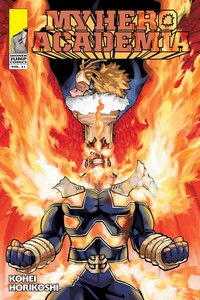Review
by Nick Creamer,My Hero Academia - Volume 21
| Synopsis: |  |
||
With society still reeling from the loss of its Symbol of Peace, recently promoted “number one hero” Endeavor is well aware he has a long way to go in gaining the public's trust. And when a new and seemingly invincible villain begins wreaking havoc, he might just get his chance - that is, if he can actually survive the battle. Meanwhile, Midoriya and his fellow students find themselves returning to the academic grind in the most action-packed way possible: through a fresh faceoff with their 1-B rivals! |
|||
| Review: | |||
Endeavor's succession of All Might has led to some interesting complications of My Hero Academia's moral calculus. Outside of his frequent willingness to push Midoriya too far, All Might is pretty close to a perfect person; strong and yet kind, aspirational yet approachable, and utterly aligned with a specific ideal of justice. In contrast, Endeavor doesn't just lack that human touch - he's a genuine abuser, a man who destroyed his family, and who is attempting to make up for his profound prior cruelty in spite of still being a man largely driven by resentment and anger. Endeavor is, by all accounts, just not a particularly nice person - and with him taking center stage, My Hero Academia has shifted from asking the general, uplifting “can anyone be a hero” to the specific, thorny “can this specific man be inspirational, or even fundamentally redeemed?” It's a complicated question, and one that your average shonen manga doesn't necessarily possess the nuance or emotional vocabulary to thoughtfully explore. This volume does its best, though, and some of the strongest material here concerns the diverse reactions expressed by Endeavor's family in regards to his seeking forgiveness. Todoroki's own hard-fought emotional growth comes through clearly in his measured responses to Endeavor, and in a larger thematic sense, Endeavor's trials dovetail neatly with My Hero Academia's larger reflections on the mutable nature of our destiny, and the limitations of labels like "hero" or "villain." While volume twenty-one's first few chapters are largely centered on Endeavor, Horikoshi returns to My Hero Academia's roots in its second half, as classes 1-A and 1-B are pitted against each other in an old-fashioned scrimmage battle. Paired up into four-on-four teams, with general studies' Shinso tossed in for seasoning, these chapters embody one of My Hero Academia's most fundamental and ever-engaging hooks: the joy of seeing diverse, unique powers combine and collide against each other. This volume's second half is a generous buffet of unique matchups, fun tactical gambits, and thrilling visual payoffs. With so much of My Hero Academia's recent action having focused on Midoriya and his immediate circle, watching characters like Tsuyu or Tokoyami demonstrate their new strengths serves as a welcome return to My Hero Academia's initial, ensemble appeal. These battles also demonstrate Horikoshi's flair for strategic innovation; there are clever schemes and dramatic reversals throughout, as My Hero's stars demonstrate ever more flexibility in the application of their distinctive powers. My one major complaint with this segment would be the awkward integration of Shinso's power. Shinso is able to command anyone who responds to something he says, a power this volume compliments with a voice box capable of mimicking other voices, in order to better trick his opponents into responding to him. The problem is, this volume makes no effort to visually signify when it's actually Shinso that's speaking by altering his voice, meaning the moments where he actually takes control of an opponent are often unclear, or only parsable in retrospect. The end result is that Shinso's battles generally have to be read through at least a couple times to actually scan, resulting in a less-than-thrilling dramatic experience. Still, that's a relatively minor complaint against a volume that embodies many of My Hero Academia's greatest qualities, both in terms of this manga's original pitch, as well as its recently expanded scope. I appreciate Horikoshi's attempts to find the human core of a character like Endeavor, and am also happy to see 1-A and 1-B at it again, reveling in the sheer joy of superpowers in motion. My Hero Academia feels as confident as ever. |
| Grade: | |||
|
Overall : B+
Story : B+
Art : B
+ Endeavor's public and personal conflicts allow My Hero Academia to expand its thematic scope, while battles at school embody the manga's original appeal. |
|||
| discuss this in the forum (4 posts) | | |||
| Production Info: | ||
|
Full encyclopedia details about |
||